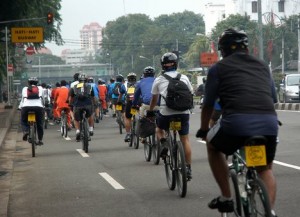
CYCLING, which is an inexpensive way to commute and avoid traffic chaos, is one of the best all-round cardiovascular exercises.
It is almost 7 in the morning and nearly every road in Metro Manila is starting to become clogged and saturated with all sorts of vehicles.
Amid these traffic chaos are bicycle commuters quietly weaving through the gridlock and successfully making their way to their respective destinations.
Most of these cyclists are going to work. A few of them are headed to school or are just carrying out their early morning workout.
But aside from providing an affordable means of transport, cyclists are also strengthening the functioning of their heart—by as much as 3 to 7 percent, improving their lung function, burning more calories, lowering total cholesterol levels and even decreasing stress.
Cardiovascular health
“Cycling improves one’s cardiovascular health because during this activity, the muscles demand more oxygen-rich blood, and give off more carbon dioxide and other waste products. And if you follow a consistent aerobic exercise regimen like cycling to get to and from work or school—your heart will eventually grow stronger,” assured Dr. Adolfo Bellosillo, head of the Makati Medical Center’s Cardiac Rehabilitation and Preventive Cardiology Unit.
Bellosillo, who is founder and president of the Foundation for Lay Education on Heart Diseases, identified biking and even stationary biking as one of the exercises that are even recommended to those who just survived a recent heart attack.
In fact, according to the British Heart Foundation, around 10,000 fatal heart attacks could be avoided each year if people kept themselves fitter.
If properly supervised by a doctor, regular cycling reduces the likelihood of heart attack as studies from Purdue University in the United States have shown that regular cycling—even as little as 30 kilometers a week—can already cut one’s risk of heart disease by up to 50 percent.
Considering that most of the rider’s weight is taken by the saddle, the skeleton and joints don’t take much battering, which will prove helpful to those who are still overweight or have preexisting joint or muscle problems that will be aggravated if they decide to walk or jog.
Most attractive advantage
“One of the most attractive advantages of cycling for fitness is that you could combine it with commuting, getting to work earlier and feeling fresher after an invigorating ride. Best of all, you don’t need to buy expensive bikes and as long as your bike is properly tuned up (tires properly inflated, brakes in good condition and moving parts properly oiled) and adjusted to your height and reach (ensure proper riding position),” the doctor suggested.
According to the National Forum for Coronary Heart Disease Foundation in the United States, regular cyclists enjoy a fitness level equal to that of a person 10 years younger. This finding is also supported by researchers in the United Kingdom that found their middle-aged cyclists to be typically as fit as someone 10 years younger.
And riding to work is much more practical if the distance is no more than 8 kilometers. In fact, commuting time using a bike at this distance will be halved if the usual route is perennially clogged. While doing this chore, the cyclist would be burning calories equivalent to drinking six cans of regular soft drink.
Disease prevention
“Moreover, cycling (as well as other exercises) combats the dangers of a sedentary lifestyle, which increases the risks of cancer, heart disease, diabetes, osteoporosis and respiratory ailments. All of these diseases can be prevented—even reversed—with regular exercise and what better way to do this is through cycling, which increases the heart’s ability to pump blood even when you are sitting still.
But of course, like any other activities, cycling also involves risk so Bellosillo is reminding that if one has been diagnosed with cardiovascular problem, he/she must consult a doctor first to make sure whether such particular exercise regimen is safe and would outweigh the risk.
But the good news is, researchers from The Netherlands found that on average, the estimated health benefits of cycling were substantially larger than the risks relative to car driving for individuals shifting their mode of transport.